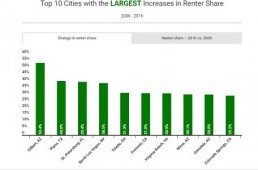
March 16, 2018 | by Katie Claflin
Categories: Affordable Housing, Homeownership, Rental Housing
In January 2018, the national apartment search website RentCafé released a study on the make-up of homeowners and renters in major U.S. cities.
Analyzing U.S. Census Bureau data, RentCafé found that renters now comprise the majority of households in 42 of the 100 largest U.S. cities. For comparison, ten years ago renters held the majority in only 20 of the top 100 cities. That means 22 U.S. cities changed from a homeowner to renter majority in the past 10 years.
Here are two other key takeaways from the study:
Here’s how all of the Texas cities ranked by percentage increase of renters vs. homeowners:
According to RentCafé, no. While the statistics seem alarming, RentCafé argues that the increase in renters over the past 10 years is still due primarily to the economic crisis of 2008, rather than a shift in attitudes about homeownership.
As evidence, RentCafé stresses that while the renter population grew faster than the owner population from 2007 to 2010, the gap started to close again after 2010. By 2016, the number of homeowners actually increased by 0.9% while renters decreased by 0.1%, marking the first time since 2006 that the number of homeowners increased rather than decreased.
In fact, the 2016 homeowner vs. renter percentages mirrored those pre-recession. According to RentCafé, this indicates that while the economic crisis had a significant impact, it takes more than a recession to change Americans' attitudes about homeownership.
Click here to read the full study by RentCafé.
On the House blog posts are meant to provide general information on various housing-related issues, research and programs. We are not liable for any errors or inaccuracies in the information provided by blog sources. Furthermore, this blog is not legal advice and should not be used as a substitute for legal advice from a licensed professional attorney.
In San Antonio, I think the main reason the rental market grew is the low inventory of homes to buy. More people moving into San Antonio with not enough pre-owned homes to choose from. New homes inventory slowly catching up, but mostly areas outside the outer loop 1604.
TSAHC reviews all blog comments before they are posted to ensure a positive experience for our online community. Off-topic comments; hostile, derogatory or deliberately insulting comments; and comments specifically promoting goods and services will not be posted.
Approved comments will be published in their entirety. Personal information will not be removed unless it pertains to someone other than the person submitting the comment. For more information, please see our Comment Posting Guidelines.
To remove a previously submitted and published comment, please contact Anna Orendain at [email protected].
If you have a question regarding any of TSAHC's programs, please contact us.

Has anyone studied the impact of the aging population on these statistics? Without doing that, they could be skewed. As the baby boomers downsize and age out of independent living, they tend to sell their larger homes and either buy smaller ones , rent, or move to some kind of retirement community that doesn’t involve home ownership. Since the baby boomers represent a larger percentage of the population now, some kind of discriminant function analysis is warranted to be sure the correct conclusions are made from the data gathered. Also, without knowing the demographics of the cities mentioned and using some sort of discriminant function or multiple regression analysis, they truly cannot be reasonably compared.
Attitudes about home ownership differ depending on people’s stages of life. Owning a home while young and raising a family is completely different from owning one in your 60s or 70s and having to do yard work and other maintenance.
Thoughts to ponder.